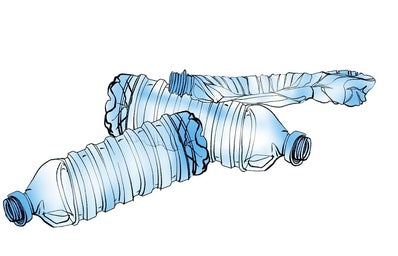The issue of plastic pollution has gained a lot of traction in recent years and in response, many countries have begun imposing plastic bans. This includes Canada, which is currently in the process of formulating a single-use plastic (SUP) ban to come in effect by the end of this year.
Last October, the Canadian government released a discussion paper on its proposed plan to shift the Canadian plastic economy from linear to circular by banning some SUP items based on certain criteria.
View the six main single-use plastic ban criteria by clicking here.
Photo by Ocean Cleanup Group from Unsplash / Original design by Daphnée Lacroix from Canva
Underwhelmingly enough, the list included a staggering total of six items: plastic checkout bags, stir sticks, six-pack rings, cutlery, straw and food service ware.
This is profusely insufficient as it excludes many important SUPs that do meet the ban’s qualifications.
Environment Minister Jonathan Wilkinson himself recognized the small impact the ban will have, stating that it covers “a fraction of one percent” of the SUP products we use.
We are long past the point where we can rely on minimal-impact solutions to combat plastic pollution. The environment requires unreserved and effective actions, something the current proposed ban cannot achieve.
Public opinion and ENGOs
According to a poll commissioned by Oceana Canada, an environmental NGO, two-thirds of Canadians polled want to see other harmful items added to the list, including hot and cold drink cups, cigarette filters and styrofoams.
Staff at Oceana Canada are also unimpressed with the ban. “There is public appetite for stronger federal action,” said Oceana Canada plastic campaigner Ashley Wallis in a press release. “Now is the time to meaningfully reduce plastic production and use, including banning more of the unnecessary and harmful single-use plastics….”
Not only is a majority of people siding with the ban’s expansion, but enough scientific evidence shows that a wider ban is exactly what the environment requires.
Scientific evidence
Two independent studies published in the journal Science last September found that the rapid growth of the plastic industry is outpacing our ability to collect and recycle plastic waste and in turn, is the principal culprit for the exponential amounts of plastics found in the seas. Both studies came to the conclusion that decreasing the production of virgin plastic is fundamental to reduce plastic waste.
View some quick facts about plastics production and pollution by clicking here.
Photo by Angela Compagnone from Unsplash / Original design by Daphnée Lacroix from Canva
In relation, according to a peer-reviewed article published on ScienceDirect, landfilling is currently the main disposal method of SUPs which enables large amounts of plastics to continuously leak into the environment. As they degrade into microplastics, SUPs release toxic chemicals in the air and contaminate the soils and waters.
Microplastics contamination is on a steady rise, to the point where researchers have recently discovered that humans are ingesting thousands of pieces per year.
Unfortunately, despite those findings, only few studies have been conducted on the specific effects of plastics on the environment and human health–a primary argument of the plastics industry which is siding against the adoption of a plastic ban.
But the little data that exists to date is all the more reason to prevent further environmental harm, especially when the lack of science is partly due to plastics’ decomposition into microplastics.
“It’s hard to track what happens to consumer products… since their disintegration into microplastics makes them hard to identify,” said environment scientist Max Liboiron.
Hence, eliminating the identifiable threat rather than waiting until it decomposes into unmeasurable tiny pieces whose effects remain unknown is the safe and responsible thing to do.
What about recycling?
Despite the few studies, the need to significantly reduce plastic waste is clear. What better way to do so than to cut the problem at the source by preventing the production of more harmful and unnecessary SUPs?
Of course, the plastics industry disagrees. Its leading solution is rather recycling for its capacity to reduce plastic pollution without radical impacts on the economy. Realistically, however, this isn’t a viable solution as the recycling industry encompasses too many challenges, including its inability to compete with the prices of virgin resins for plastic production, its low collection rates of plastics and even lower recycling rates.
“Our recycling systems can’t handle the volume or complexity of materials on the market today,” said Wallis. “Meanwhile, plastic production is expected to double by 2035. We urgently need to reduce unnecessary plastic use.”
Researchers have also clearly indicated that single solutions to plastic pollution are pointless. Consequently, banning more SUPs while the recycling sector undergoes an institutional reform is an immediate and more efficient solution.
Economic objections
The opposition to a plastic ban also regroups some citizens whose support of the policy is overpowered by their objection to pay higher prices of goods and by the perceived consequences the ban will have on the economy.
However, as the adoption of plastic bans is occurring worldwide, greener alternatives will become the new norm, thus will become more affordable. Likewise, the elimination of numerous SUPs will create new markets for alternative products and generate new jobs.
The government said it too: “By improving how we manage plastic waste and investing in innovative solutions, we can reduce 1.8 million tonnes of carbon pollution, generate billions of dollars in revenue, and create approximately 42,000 jobs.”



